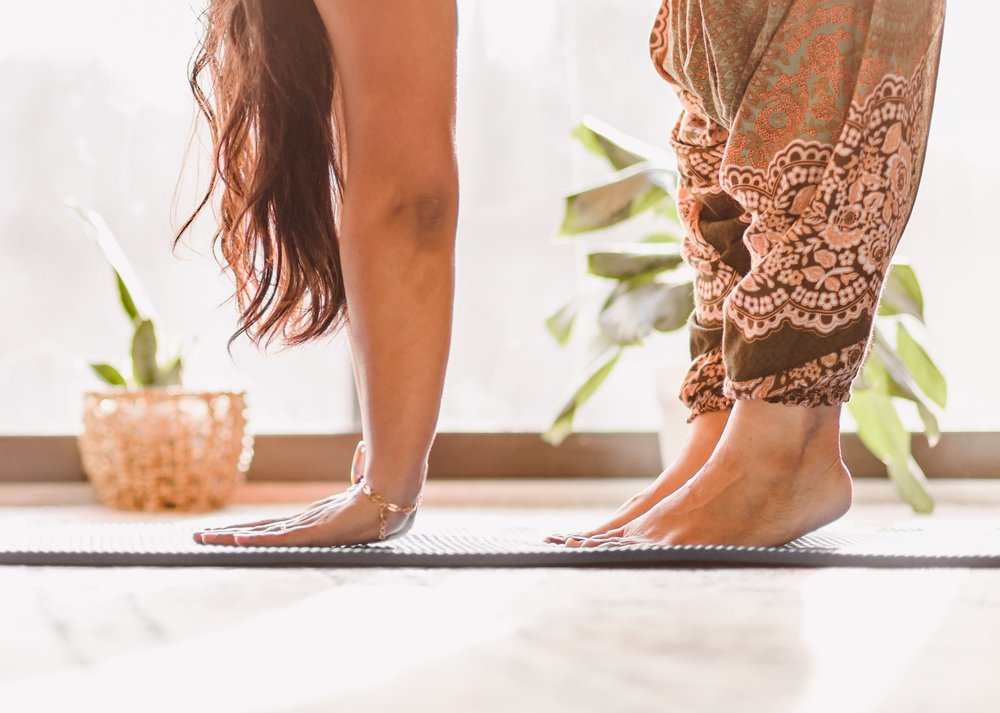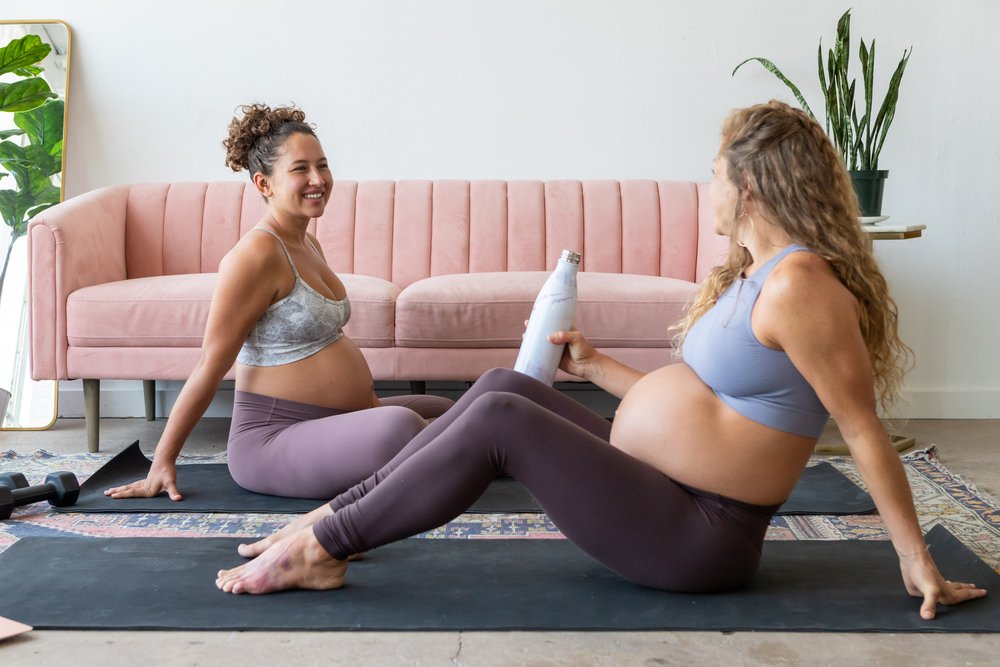The Surprising Connection Between Your Feet and Your Pelvic Floor
Addressing an imbalance in your pelvic floor could start with your feet. Check out our tips for healthy feet and a healthy pelvic floor during pregnancy.

The innate wisdom and connections within our bodies are crazy. Did you know that there is a deep relationship between your feet and the muscles of the pelvic floor? When addressing a pelvic floor imbalance - or even an Injury such as POP or incontinence - we should look at other areas that could be contributing to the issue.
Healthy feet are the literal foundation to a strong and healthy:
Body alignment
Pelvic floor
Core
Movement functionality
The reality is that everything in your body is interconnected, and tightness anywhere in the chain can create strain elsewhere in the body, impacting muscles, joints, and ligaments. By tilting the pelvis backward to a neutral position, for example, you engage the lower abdominal muscles for better overall stability.
Whether you’re experiencing a “niggle” like a small, annoying pain in your pelvic floor or a full-blown injury, it’s worth investigating all the links in the chain to find the root of the problem. If you want a healthier, more balanced, and stronger pelvic floor, follow these tips and give your feet and pelvic floor the love they deserve.
The Connection Between Your Feet, Core, and Pelvic Floor
The most common techniques for addressing a pelvic floor imbalance or injuries like POP and incontinence tend to focus on techniques like:
Manual therapy
Breathwork
Pelvic floor isolation exercises AND
Tapping into the deepest layers of the core
While these are all effective techniques for healing pelvic floor issues, it’s important to investigate where else the problem could be stemming from. Your feet are one of the most commonly overlooked (and often underserved) areas of your body.
Many women notice that their feet grow in length and width over the course of their pregnancy due to hormonal changes and excess fluid accumulation. Swollen feet are a common pregnancy side-effect and more than just an inconvenience when it comes to sizing up a pair of shoes. The changes to your feet can cause your arches to become flatter, putting increased strain on the muscles of your pelvic floor.
Not only does your growing belly cause shifts in your posture and the way you distribute that weight, but flat feet can also cause your pelvis to tilt differently. If the pelvis rotates too far forward or backward, it can cause insufficient support in the lumbar spine, creating a waterfall effect of other issues and ultimately contributing to dysfunction in both the pelvic floor and core if left unaddressed.
Luckily just by giving your feet some regular TLC you can reduce the severity of any swelling you may experience and ensure your feet are helping to balance your pelvis, rather than continually throwing it off-kilter.
Avoiding Swollen Feet and Ankles During Pregnancy
While Edema, or swollen feet and ankles, are common during pregnancy, not every woman will experience this side effect and there are several ways to reduce the severity of any swelling that does occur. At The Bloom Method, we are passionate about educating mamas and myth-busting - so we want you to know, growing a baby doesn’t guarantee that you’ll also be growing your feet!
First off: There’s a reason your body retains water during pregnancy. Excess water helps ensure the efficient transfer of oxygen and nutrition to your baby. But because we spend so much time with our feet on the ground, gravity tends to cause fluid to pool around the feet and ankles, although blood vessels and pressure on the veins can also contribute.

Perhaps counter to what you might think, one of the easiest and most important ways to avoid fluid retention is actually to stay hydrated. Drinking plenty of water helps improve circulation, which flushes your body of toxins and keeps fluid from pooling. Caffeine and salt both cause dehydration and thus water retention, so limiting your intake of both is helpful when it comes to keeping things circulating.
Exercise is a powerful force when it comes to getting blood, oxygen, and water moving. So log onto Studio Bloom and get your sweat on! In general, try to avoid standing or sitting for too long. Extended periods of sitting in particular decrease blood flow, which can lead to a whole host of other health complications beyond swollen feet. Even if you just get up to get a glass of water - hydrate! - and then walk back to your desk, which counts as getting your body moving.
Some other tips for avoiding swollen feet are:
Put your feet up! Using a footstool at your desk, propping your feet up while you watch Netflix (or go down a scroll hole - no judgement!) and even using a little foot pillow for sleep can help with circulation.
Many mamas swear by compression socks. A little bit of compression definitely helps maintain consistent blood flow, so consider picking up a pair. We love Belly Bandit’s maternity compression leggings.
The yoga pose legs up the wall can be great for circulation and mindfulness. Try to unwind in this position for 5 to 10 minutes before bed for the ultimate night’s sleep.
Hydrating, exercising, and elevating your feet will not only reduce the chances of edema but also flush toxins, ensure lots of oxygen and nutrients are getting to your baby, and keep you feeling sane while navigating the ins and outs of pregnancy.
The Fundamentals of Foot Health
All too often, our feet get overlooked and underappreciated. Just paying a bit more attention to the part of your body that connects you to the ground and carries you around on a daily basis can make a world of difference.
Simply following these foot health tips can work wonders for your feet and body alignment.
Walk barefoot as much as possible (if you can exercise barefoot, even better!)
Choose smart footwear (this is vital for your littles too) we love Vivo Barefoot
Roll out the bottom of your feet regularly
Work on foot/ankle/toe mobility
If your toes are jammed together due to years of wearing bad footwear, they deserve to be separated, check out The Toe Spacer.
When standing and walking, notice how your foot makes contact with the earth beneath you. Hint: all four corners should be involved.
All of these exercises will improve your sense of the connection between your feet and the ground, and your feet and different parts of your body - especially your pelvic floor. Then when you are doing a Studio Bloom class, chasing a toddler, or just going about your day, the connection between your feet, your body, and your surroundings become more established.
Bottom Line:
Use these tips to establish a stronger connection between your feet and your pelvic floor. A stronger connection may help you avoid falling back into old habits that aren’t serving you, and ultimately prevent collapsing into your inner foot arches, causing inflammation and possible damage to your tendons.
All of these little tweaks to your posture and body awareness add up to fewer aches and pains during pregnancy and greater ease of movement. By making these adjustments and becoming more aware of your body alignment and movement functionality, you can repair the relationship between your feet and the rest of your body, and in doing so solve any pelvic floor issues you may be experiencing.
Give your feet some extra love today, so that you can love your pelvic floor a little better too!



